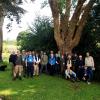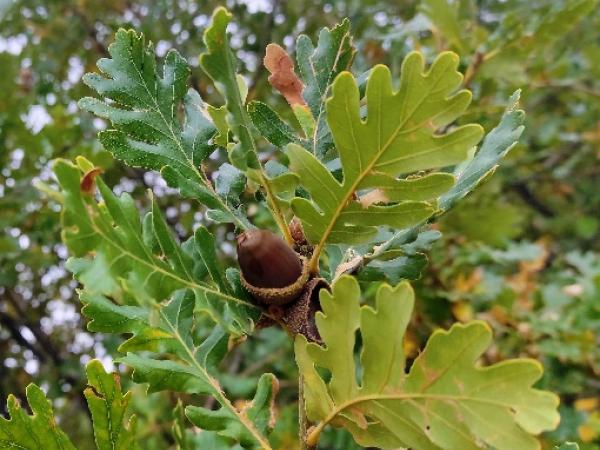Editor's Picks
Plant Focus
When Christine and Ben Battle moved into Congrove Cottage in Upton Cheyney, near the city of Bath in the United Kingdom, they did not know the property concealed an old arboretum planted over 100 years prior to their arrival. There was an area of overgrown woodland along the southern border of the property, and shortly after moving in, one of the locals commented that they had "bought the old arboretum". During restoration work on the cottage in 1998, the remnants of this arboretum were discovered around the house and along the river. So Christine asked tree specialist Tony Titchen from Westonbirt Arboretum, to investigate.
"He disappeared into the undergrowth for several hours, and came back covered in bracken and twigs, very excited," she says. "There were 116 rare species of trees there, including unusual conifers and beeches, as well as incredible wild flowers.”
| Congrove Cottage in spring. |
The arboretum had been created by a Canon Parker in the 1890s, when a sizeable pinetum was planted. Christine and Ben set about restoring the arboretum, and aside from the treasures discovered by Tony Titchen, they have planted some 3,000 specimen trees, plus another 2,000 native woodland species to replace windbreaks and gaps in the woods behind the house. Of special note are the 200 different species of oak Christine has established, constituting one of the most important collections in the UK. The oaks do well in a favorable microclimate on the south-facing slope of the valley below the cottage. Plenty of sunshine and copious rain and good drainage combined with shelterbelts of mature native trees provide warmth, shelter and nourishment - an ideal habitat for oaks. Magnolias also flourish in these conditions, as do some of the more tender conifers. In all, some 25 to 30 acres of the 65-acre property are now planted with specimen trees or native woodland windbreaks.
We were able to interview Christine via e-mail and ask her about her fascination with oaks:
| New growth on Quercus crassifolia |
You found an old arboretum hidden in your property, with a wide variety of trees. But your new plantings seem to have included more oaks than any other trees. Why is that?
It was an accident that lead me to collect oaks above other genera, although if you visit Congrove Arboretum you will find quite a diverse collection of plants including Magnolia, Aesculus, Pinus, Abies and Juglans to name but a few. Sadly I’m a bit of a magpie when it comes to acquiring specimens and my favorite suppliers know that if they label something up as having big leaves, showy flowers, attractive fruit or just rarity value I’ll almost certainly want it for the collection. But back to the oaks. I’d invited a great friend of ours down for the weekend, James MacEwen, and when he saw my nascent collection of trees he was keen to introduce me to a friend of his who at that time was working at Hillier Gardens – Allen Coombes. He was so kind and generous with his time, and was so enthusiastic about Quercus that I couldn’t help but be enthused in my turn. And then he sent me some wild-collected acorns from a recent collecting trip in Taiwan. Just holding these extraordinary seeds in my hand was enough to fire my imagination, and then they started germinating – wow! I was well and truly hooked.
| View of the main section of the arboretum on the south-facing slope of the valley. |
How have you obtained your oaks? Do you grow all from seed or do you propagate by other means?
A lot of my oaks have come from wild-collected seed that I’ve propagated myself, otherwise from swaps with other enthusiasts. Nick Macer of Pan-Global Plants is probably my best source of nursery grown plants, as he always has several rarities for sale, often collected by him on field-trips. In the past I’ve acquired specimens from other nurseries, but as your collection grows it gets harder and harder to find new species from commercial sources, as they often focus on the better known species, for obvious financial reasons. Apart from growing from seed, I have had some small success with cuttings, but this is quite a tricky method of propagation for me, as I don’t really have a good enough watering system or temperature control in the greenhouse. My greatest success was with some cuttings of Q. semecarpifolia a few years ago, all of which are now planted out and growing happily in the arboretum.
| Abies sp. |
Could you single out some favorite oak species and tell us what special attraction they hold?
It is so hard to do this! At different times of year, different species of oak catch my eye and make me pause in pleasure. Spring is a particularly good time for oak gazing in my opinion, so right now one of my favorite species has to be my Q. canariensis, which this week is absolutely laden with fat crunchy bunches of emerging male flowers. The Mexican oaks of course, in particular Q. crassifolia, have that wondrously rich red felty new growth which I adore. An oak new to my collection which I think is just delightful is the modest Q. hypoleucoides… until you turn over the leaf and see why it is known as the Silverleaf Oak. In fall, the red oaks come into their own and I am always dazzled by the varying colors to be found on just one tree. Q. phellos is particularly fine and its dying leaves offer every shade from lemon yellow through shrimp pink to bright orange and vermilion. Last but not least is Q. imbricaria which, in my opinion, gives pleasure at nearly every time of year. It has an attractive shape, lovely bark and the leaves turn glorious shiny shades of red, magenta and burgundy in the fall. But really this is such a hard question to answer because when I go out this afternoon I’ll find about 20 more species which I’ll regret not mentioning here.
| Abies koreana |
Now that you are planning to move to be closer to family, what does the future hold for your oak collection?
We are very fortunate in that the family which has bought Congrove love the valley and the trees within it. The oaks will be fine – if left to their own devices trees tend to quietly go about the business of putting out roots and new growth without much ado. And this will sound very fanciful but I feel there is a sort of magic here which gets to you in the end. That was certainly true of Ben and me when we moved here 17 years ago. We’d come from London and I remember thinking as we drove past the gigantic old Turkey oaks along the track, “Oh my goodness, what a lot of enormous trees; how will we ever know how to look after all these?”. But actually within a few months we’d established a whole lot of wildlife habitats like owl and kestrel boxes, fenced off the old trees from the cattle, and started planting. It just seemed the right thing to do at the time. I’m sure the new owners, having settled in, will want to do their own "thing," but they will probably find that without consciously thinking about it, Congrove will have got under their skin like it did me and Ben, and shown them the way to go.
The restoration of the arboretum and the new plantings went hand in hand with Christine’s development as a botanical artist (see our article about her drawings of oaks here). Ben and Christine will soon be moving away from Congrove, not before hosting an Oak Open Day there on July 6, 2014. Members who are able to attend should not miss this opportunity to see a remarkable young collection of rare oaks.
References:
Simons, J. W. (2013, September 30). Congrove Cottage: natural inspiration at an artist's retreat. The Telegraph. Retrieved from http://www.telegraph.co.uk/
Dessoy, G. Botanical notes: Congrove Arboretum, Christine Battle. Arboretum Warmrood website. www.warmrood.be. Accessed May 2014.















